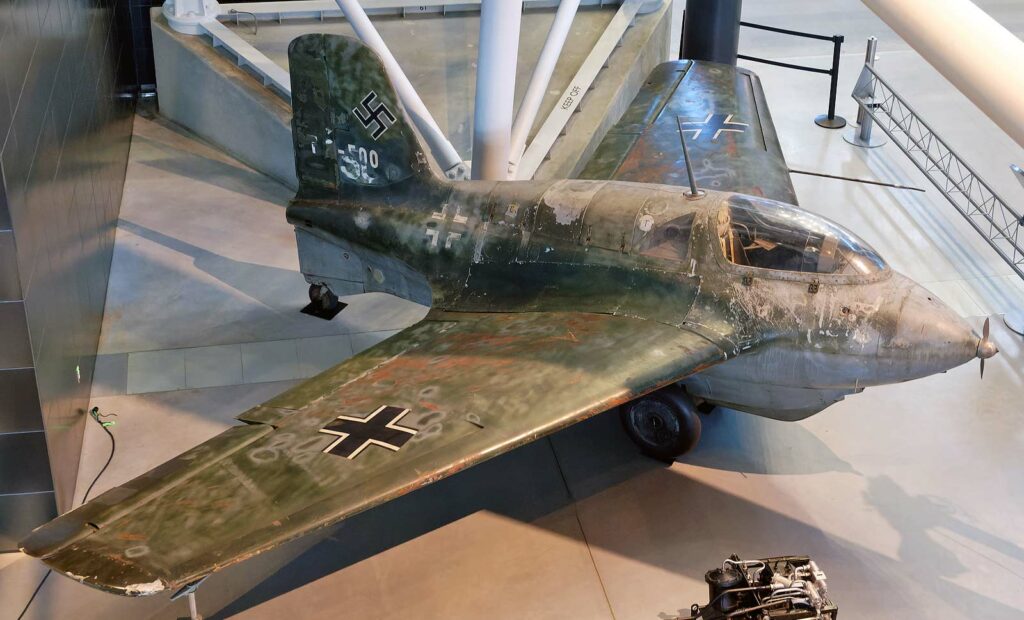The Messerschmitt Me 163 Komet, a WWII German rocket-powered interceptor, notable for its unprecedented speed and climb rate.
This article offers an in-depth analysis of the Messerschmitt Me 163 Komet, a unique rocket-powered aircraft of World War II. It explores the Komet’s development, innovative design, remarkable performance, and combat use, highlighting its role as the first and only operational rocket-powered fighter aircraft and its impact on aerial warfare.
The Messerschmitt Me 163 Komet was a groundbreaking aircraft in the history of aviation, representing the pinnacle of rocket-powered flight during World War II. Developed by Germany as an interceptor, it was designed to quickly engage and destroy enemy bombers. This article delves into the Komet’s development, design, performance capabilities, and its role in military aviation.
History of the Development of the Messerschmitt Me 163 Komet
During the early stages of World War II, Germany sought advanced technologies to gain air superiority. The development of the Me 163 Komet, under the direction of Alexander Lippisch, was part of this initiative. The project aimed to create a high-speed interceptor capable of countering Allied bomber formations.
The Me 163’s development was driven by the need for a defensive weapon that could quickly reach high altitudes and engage enemy aircraft with unprecedented speed. The first powered flight of the Me 163 occurred on August 13, 1941. The development of this aircraft occurred during a period of rapid technological advancements in aviation, characterized by the exploration of rocket propulsion.
Its development marked a significant milestone in the use of rocket technology in aviation.
Design of the Messerschmitt Me 163 Komet
The Me 163 Komet featured a revolutionary design, utilizing a rocket engine, the Walter HWK 509, for propulsion. This engine provided immense thrust, enabling the aircraft to reach extraordinary speeds and altitudes. The Komet had a length of 5.7 meters and a wingspan of 9.33 meters. Its design was aerodynamically efficient, with a swept wing configuration that was ahead of its time.
The advantages of the Me 163’s design included its incredible rate of climb and speed, which were unmatched by any piston-engined aircraft of the era. However, the drawbacks were significant: the rocket engine’s limited fuel capacity offered only a few minutes of powered flight, followed by a glide back to base, and the volatile nature of the rocket fuel posed a high risk to pilots.

Performance of the Messerschmitt Me 163 Komet
The performance of the Me 163 Komet was extraordinary. It could reach speeds of up to 960 km/h (596 mph), with a service ceiling exceeding 12,000 meters (39,370 feet). Its rate of climb was unparalleled, allowing it to intercept enemy aircraft quickly.
In comparison to contemporaries like the American P-51 Mustang or the British Spitfire, the Me 163 was significantly faster and could reach higher altitudes, but it lacked endurance and operational flexibility.
Military Use and Combat of the Messerschmitt Me 163 Komet
The Me 163 was armed with two 30mm MK 108 cannons, providing formidable firepower. It was used primarily as an interceptor against Allied bomber formations. Due to its high speed, it was difficult for enemy gunners to target.
The Komet’s operational use was limited, partly due to its short flight duration and the challenges of landing the aircraft. Its success in combat was mixed, with several aircraft achieving kills, but its overall impact on the air war was minimal.
The Me 163 was not exported to other countries and remained a unique part of Germany’s air defenses during World War II. Post-war, its innovative design influenced the development of rocket and jet aircraft, but the Komet itself was not further developed or used.
The Messerschmitt Me 163 Komet stands as a remarkable achievement in aviation history. Its development and deployment showcased the extreme potential of rocket-powered flight, although practical limitations hindered its effectiveness. The legacy of the Me 163 lies in its status as a technological marvel of its time, illustrating both the innovative spirit and the desperate measures of wartime aviation development.
Back to the Fighter Jet section.